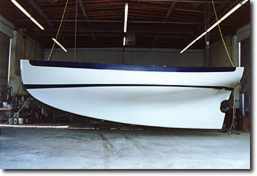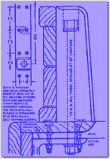Fabrication
The Sam L Morse Co. takes great pride in our extremely careful, strong construction. No effort is spared in the task of creating the most seaworthy, trustworthy yacht anywhere. This construction detail page is only an overview of our painstaking approach to yacht construction. Those who have seen a Sam L. Morse yacht find that very few other vessels measure up to our standards of construction.
THE HULL

The two-part female mold first gets a white or light ivory gel coat above the boot stripe. A contrasting color of your choice is applied to the sheer stripe and boot stripe during this initial gel coating. Below the top of the boot stripe, a vinyl ester primer is applied for blister resistance. After the color gel coating is complete, a black gel coat is applied. Then structural lay-up begins with a skin coat of 1.5 oz mat and 7.5 oz cloth using Hydrex Vinylester Resins to prevent osmosis. This is followed by three layers of 1.5 oz mat and 24 oz roving over the entire hull. An additional layer of 1.5 oz mat and 24 oz roving is applied below the water line and repeated again at the transom, forward at the bow and at the chainplate location. Finally, the entire hull has another layer of 1.5 oz mat and 7.5 oz cloth added. All materials are hand laid and hand squeegeed to ensure a solid lay-up without air bubbles. The result is a hull that is about 3/8″ at the sheer, 1/2″ at the water line, increasing to over 1″ thick near the bottom of the hull. The actual thickness at the bottom of the keel is greater than 1″ because we overlap layers at this location. The hull will weigh approximately 2,600 lbs. when finished.
(As an option, 3 coats of epoxy InterProtect 3000/3001 is applied at least 30 days after the hull has cured. With this protection the hull will come with a 5-year warranty against osmosis.)
The solid, pre-cast 4,600lb lead ballast is set inside the hull cavity. After the hull is leveled and a dam installed, resin is poured into this cavity to completely encapsulate the ballast. Three layers of 1.5 oz mat and 24 oz roving are applied over the encapsulated ballast to ensure a lifetime of trouble free use. The mast step is set on top of this solid mass.
THE DECK

The deck gets similar treatment. The deck mold is gel coated with the same white or light ivory as the hull. The non-skid is a slightly darker camel color, or the color of your choice. This is followed by black gel coat and a layer of 1.5 oz mat, 7.5 oz cloth, 1.5 oz mat, 24 oz roving, 1.5 oz mat and scored 1/2″ marine plywood core for stiffening. Extra layers of plywood are used where the mast and bitts penetrate the deck. The Plywood core permits hardware to be mounted anywhere without reinforcing. The plywood core is encapsulated with additional lay-ups of 1.5 oz mat and 24 oz roving. Cockpit locker coamings are molded into the deck, providing excellent drainage for the lazzarette and port side cockpit lockers.
THE INTERIOR
There are two basic ways of creating the interior features of a yacht. In “production” boats the approach is to use a liner. This is a one-piece or segmented fiberglass molded part that has most of the interior features molded in. The advantage of this approach is cost. Once the tooling has been paid for, the parts are easily made. It requires fewer hours of labor and usually less skilled labor to finish out a boat built in this fashion. Disadvantages include the inherent difficulty of fastening the liner to the hull resulting in a much weaker boat, inaccessibility of the interior of the hull itself, and lack of flexibility in making any customer requested interior changes without going to the trouble and expense of new tooling. The Bristol Channel Cutter and Falmouth Cutter feature an entirely hand fabricated interior. No liners are used.
After the hull has been leveled and the ballast encapsulated the bulkheads are installed. Bulkheads are 3/4″ marine plywood bonded directly to the hull on both sides with 12″ of 1.5 oz mat, 24 oz roving, 1.5 oz mat, and 7.5 oz cloth. A 2″ hole is cut about every 18″ around the perimeter on the main bulkhead so bonding on both sides will fuse together through the holes. A 1″ foam barrier is installed between the bulkheads and the hull. This cushioning pad prevents hard point failure of the hull after years of yielding to the forces of the sea. The more bulkheads bonded to the hull and deck, the stronger the boat. There are 4 bulkheads bonded 360 degrees, and three additional quarter bulkheads bonded to the hull and deck amidships.
After the bulkheads have been installed, the furniture is fitted and bonded in a similar fashion as the bulkheads. All furniture is bonded on both sides using two layers of 8″ 1.5 oz mat and 7.5 oz cloth. The bonding of the furniture is clearly visible because we make no attempt to hide it. Teak plywood is used on cabinet and bunk faces and finished with solid teak trim. Solid ash ceiling strips line the hull sides of all berths and workbench. The cabin sole is 1/2″ solid teak laid over 3/4″ marine ply. White fiberglass panels, grooved to resemble Tongue and Groove lumber are bonded to the bulkheads and overhead.
As semi-custom boat builders, changes to the interior layout can be made at additional expense, because the interior is essentially hand built a piece at a time. For example, the forward main bulkhead can be moved to provide a few inches of additional bunk length in the main cabin. Every point on the interior of the hull is accessible for inspection and cleaning. We have recently altered our icebox construction to create a removable, serviceable structure, providing access to that area of the hull.

After the interior is roughed in and everything is bonded to the hull, the deck is set in place. The hull has a 3.5″ in-turning flange to support the deck. After the deck is in register to the hull, it is drilled around its circumference every 5″, alternating each hole so they are not in line. The deck is raised and cleaned before 3M 5200 marine sealant is applied. After the deck is set into the sealant, 1/4″ stainless steel bolts are place through the holes and the deck is bonded to the hull flange using washers and lock nuts. After the hull to deck join is complete, the cover board is applied over this joint. This piece is screwed through the deck into the hull flange every 5″ alternating with the bolts. This deck joint is further strengthened when the bulwark stanchions are thru-bolted every 20″ using 1/2″ stainless steel bolts. After the join is complete, the bulkheads and furniture are bonded to the deck in the same manner used in bonding to the hull.
We are one of the few builders to insulate our boats under the cabin, deck and hull to the waterline. This prevents sweating and helps maintains an even temperature in any climate. As an option, the bare hull can be lined inside the lockers using a similar but denser insulation.
Our boats are more expensive to build because semi custom construction requires greater hours in fabrication, and the need for skilled craftsmen. The results meet the practical requirements of superior strength, versatility and accessibility, while retaining the beauty and integrity which Lyle Hess designed, Sam L. Morse Co. built boats are famous for.
Ask an owner what he/she thinks about the boat.